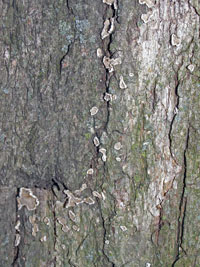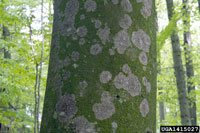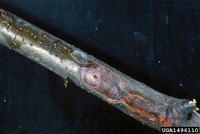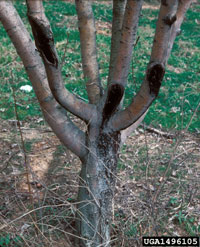Extension > Garden > Diagnose a problem > What's wrong with my plant? > Deciduous Trees > Oak > Unusual color on branch or trunk
Oak > Trunk/Branches > Unusual color on branch or trunk
1 of 3
Smooth Patch
Aleurodiscus spp. and Dendrothele spp.
- Sunken, relatively smooth, round to irregular area of bark on trunk or branches
- Affected bark is often lighter in color
- Small cream colored disks or saucer like fungal spore producing structures grow within affected area
- Has no affect on the overall health of the tree
- More information on Smooth Patch
2 of 3
Lichens
Several species
- Colorful patches on the bark of trunk and/or branches
- Can be wrinkled, in scalloped sheets, lace-like pads, bushy tufts, paint-like spots or splashes
- Forms can be flat against the bark surface or raised in leaf-like lobes, finger-like or hairy projections
- Colors may be shades of gray, green, blue, yellow, orange, or red
- More information on Lichens
3 of 3
Botryosphaeria
Botryosphaeria quercuum
- Leaves on random branch tips throughout the canopy wilt, turn brown and remain attached to twig
- Cankers with brown to black, sunken cracked bark can be found at the base of wilted twigs
- If bark is peeled back from the canker, brown streaks can be seen in the sapwood
- Small black raised pimple like fungal fruiting bodies can be seen scattered on infected twigs
- Cankers only occasionally extend into larger branches
- Damage easily confused with twig girdler damage
- More information on Botryosphaeria











